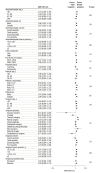Surgeon Sex and Long-Term Postoperative Outcomes Among Patients Undergoing Common Surgeries
- PMID: 37647075
- PMCID: PMC10469289
- DOI: 10.1001/jamasurg.2023.3744
Surgeon Sex and Long-Term Postoperative Outcomes Among Patients Undergoing Common Surgeries
Abstract
Importance: Sex- and gender-based differences in a surgeon's medical practice and communication may be factors in patients' perioperative outcomes. Patients treated by female surgeons have improved 30-day outcomes. However, whether these outcomes persist over longer follow-up has not been assessed.
Objective: To examine whether surgeon sex is associated with 90-day and 1-year outcomes among patients undergoing common surgeries.
Design, setting, and participants: A population-based retrospective cohort study was conducted in adults in Ontario, Canada, undergoing 1 of 25 common elective or emergent surgeries between January 1, 2007, and December 31, 2019. Analysis was performed between July 15 and October 20, 2022.
Exposure: Surgeon sex.
Main outcomes and measures: An adverse postoperative event, defined as the composite of death, readmission, or complication, was assessed at 90 days and 1 year following surgery. Secondarily, each of these outcomes was assessed individually. Outcomes were compared between patients treated by female and male surgeons using generalized estimating equations with clustering at the level of the surgical procedure, accounting for patient-, procedure-, surgeon-, anesthesiologist-, and facility-level covariates.
Results: Among 1 165 711 included patients, 151 054 were treated by a female and 1 014 657 by a male surgeon. Overall, 14.3% of the patients had 1 or more adverse postoperative outcomes at 90 days and 25.0% had 1 or more adverse postoperative outcomes 1 year following surgery. Among these, 2.0% of patients died within 90 days and 4.3% died within 1 year. Multivariable-adjusted rates of the composite end point were higher among patients treated by male than female surgeons at both 90 days (13.9% vs 12.5%; adjusted odds ratio [AOR], 1.08; 95% CI, 1.03-1.13) and 1 year (25.0% vs 20.7%; AOR, 1.06; 95% CI, 1.01-1.12). Similar patterns were observed for mortality at 90 days (0.8% vs 0.5%; AOR 1.25; 95% CI, 1.12-1.39) and 1 year (2.4% vs 1.6%; AOR, 1.24; 95% CI, 1.13-1.36).
Conclusions and relevance: After accounting for patient, procedure, surgeon, anesthesiologist, and hospital characteristics, the findings of this cohort study suggest that patients treated by female surgeons have lower rates of adverse postoperative outcomes including death at 90 days and 1 year after surgery compared with those treated by male surgeons. These findings further support differences in patient outcomes based on physician sex that warrant deeper study regarding underlying causes and potential solutions.
Conflict of interest statement
Figures
References
Publication types
MeSH terms
LinkOut - more resources
Full Text Sources
Medical



